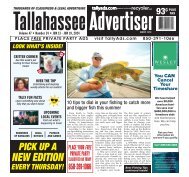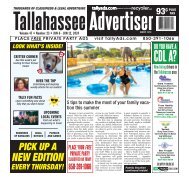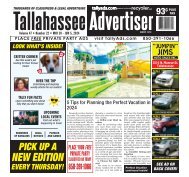TLA37_AllPages
You also want an ePaper? Increase the reach of your titles
YUMPU automatically turns print PDFs into web optimized ePapers that Google loves.
Sponsored by Mcleod software<br />
McLeodSoftware.com | 877.362.5363<br />
J. J. KELLER’S ELD INSIGHTS<br />
AOBRDs vs. ELDs:<br />
5 Key Differences<br />
Updating to an ELD mandate-compliant device by the December 16, 2019<br />
deadline may require a mere software conversion for most AOBRDs, but<br />
don’t count on it being this simple. Your drivers will need to understand the<br />
significant differences between AOBRDs and ELDs, making training<br />
imperative. Here are 5 critical requirements your drivers will need to be aware<br />
of as you prepare for the transition:<br />
1. In-Vehicle Documentation<br />
Before allowing drivers to log into an ELD, the carrier must swap out<br />
AOBRD documentation for ELD documentation, including:<br />
• The ELD user manual,<br />
• Instructions for how to transfer data,<br />
• Instructions for handling ELD malfunctions, and<br />
• Enough blank paper logs to last at least eight days<br />
2. Unassigned Driving Events & Automatically Recorded Drive Time<br />
When a driver logs in, they must accept or deny any unassigned driving<br />
time on the ELD. If the driver has unassigned driving events at the time<br />
the officer is reviewing the ELD data, the logs are considered not<br />
accurate, and can result in a citation for falsifying logs.<br />
Additionally, ELDs switch to driving status when the vehicle reaches five<br />
miles per hour, unless the driver has selected one of the special driving<br />
categories. Conversely, with an AOBRD, the driving threshold can be<br />
determined by the carrier and vendor, as long as it is reasonable.<br />
3. Form and Manner Requirements<br />
Drivers must manually input information when prompted by the ELD<br />
and required by the motor carrier or FMCSA, including notes, and a<br />
location description if needed. Drivers must also input or verify the<br />
power unit number, trailer number(s), and shipping document number if<br />
the information is not automatically loaded into the header information.<br />
4. Edits, Annotations, and Submissions<br />
Unlike AOBRDs, drivers must be provided full editing rights in an ELD<br />
system. To adjust to this change, they will need to be trained on:<br />
• What constitutes an acceptable and unacceptable edit,<br />
• How to make edits,<br />
• How to accept edits done by back-office personnel, and<br />
• Making an annotation when limit violations or something out of<br />
the ordinary occurs<br />
5. Data Transfers<br />
When using an ELD, the driver will be asked during a roadside inspection<br />
to transfer the log data directly to the officer via the FMCSA email or<br />
wireless web service, and must know whether<br />
his/her device uses the telematics or local<br />
transfer method.<br />
Not sure which type of electronic logging device you’re using?<br />
Find out by requesting your FREE ELD Compliance Check at<br />
JJKeller.com/Verify.<br />
Fleet Management System<br />
with ELogs<br />
In this issue of Truckload Authority, there is an in-depth<br />
article on the TCA Profitability Program and the successes<br />
its participants have enjoyed. Share with TCA members the<br />
importance to their company of availing themselves of this<br />
benefit.<br />
There is no other program like it. It’s the ONLY program in<br />
which a carrier can have their operational performance dissected<br />
in so many different ways. For example, carriers can review costs<br />
and revenue by mile or percentage of revenue or look at their<br />
gross margin. TPP also allows carriers to benchmark against their<br />
peers. That’s very powerful from an owner’s standpoint to then<br />
help hold your team accountable. Numbers and facts are the only<br />
way to manage a successful business.<br />
The Call on Washington, which this year will be held<br />
September 25, is one of TCA’s most important efforts to<br />
increase truckload’s visibility with our legislators and<br />
regulators in Washington. Even though it’s still almost<br />
three months away, it’s not too early to begin planning to<br />
attend, as TCA wants to increase the number of participants.<br />
Why should TCA members consider attending Call on<br />
Washington?<br />
There is a lot going on in trucking and D.C. these days and<br />
judging by the growth and positive effect our government affairs<br />
team has had in spreading our message, our members should be<br />
leading the charge. Issues like infrastructure, drug and alcohol<br />
testing, and even truck size and weight will continue to be spoken<br />
about and we must be sure that we are part of the conversation.<br />
Our first Call on Washington generated 32 attendees with over<br />
75 meetings. Last year, there were 50 attendees and over 275<br />
meetings. We, as an association, should expect positive growth<br />
from our membership that reflects the message we delivered in<br />
Las Vegas that our association should be viewed as “Truckload<br />
Strong” and continue to spread the message on Capitol Hill.<br />
Thank you, Mr. Chairman.<br />
26 Truckload Authority | www.Truckload.org TCA 2019

















